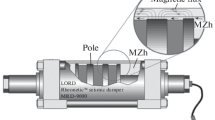Abstract
The present work is about the dynamic modelling and the experimental testing of magnetorheological (MR) dampers, especially at low frequency. The main improvement of this work over former models is the identification of dynamic parameters which are independent of the working conditions and vary only as a function of the current. A simple model is built on the basis of the literature and of a systematic experimental campaign, with the aim of simplifying the effort in retrieving the parameters and in controlling the system. The excitation current is introduced in the model as a variable, not only reducing the amount of test needed to assess the parameters, but also obtaining a faster model useful in motion control. A second order polynomial relationship between the applied current and the three variable parameters is found, showing a saturation effect at high currents. A verification test shows the reliability and the performance of the proposed model.









Similar content being viewed by others
Abbreviations
- A :
-
parameter related to hysteresis curve amplitude
- c 0 :
-
parameter related to the damping at low speed
- c 1 :
-
parameter related to the damping at high speed
- d :
-
displacement of the damper rod
- F :
-
damper force
- I :
-
applied current
- k 0 :
-
parameter related to the elasticity of the Bouc-Wen sub-model
- k 1 :
-
parameter related to the elastic force of the accumulator
- n :
-
parameter related to the evolution of the hysteresis force
- v :
-
speed of the damper rod
- x :
-
displacement of the damper
- x 0 :
-
preload of the system
- y :
-
relative displacement of the Bouc-Wen sub-model
- z :
-
evolutionary variable of the Bouc-Wen block
- α :
-
parameter related to the hysteresis force
- β :
-
parameter related to the smoothness of the hysteresis curve
- γ :
-
parameter related to the hysteresis shape
References
Gavin HP, Hanson RD, Filisko FE (1996) Electrorheological dampers, part I: analysis and design. J Appl Mech 63:669–675
Kamath GM, Hurt MK, Wereley NM (1996) Analysis and testing of Bingham plastic behavior in semi-active electrorheological fluid dampers. Smart Mater Struct 5:576–590
Wereley NM, Pang L (1998) Nondimensional analysis of semi-active electrorheological and magnetorheological dampers using approximate parallel plate models. Smart Mater Struct 7:732
Wang X, Gordaninejad F (2007) Flow analysis and modelling of field-controllable, electro- and magneto-rheological fluid dampers. J Appl Mech 74:13–22
Gamota DR, Filisko FE (1991) Dynamic mechanical studies of electrorheological materials: moderate frequencies. J Rheol 35:399–425
Liu Y, Gordaninejad F, Evrensel CA, Wang X, Hitchcock GH (2000) Semiactive control of a two-span bridge using field-controllable magneto-rheological dampers. In: Proc of SPIE conference on smart materials and structures, vol 3988, pp 199–206
Wereley NM, Lindler J, Rosenfeld N, Choi YT (2004) biviscous damping behavior in electrorheological shock absorbers. Smart Mater Struct 13:743–752
Spencer BF, Dyke SJ, Sain MK, Carlson JD (1997) Phenomenological model for magnetorheological dampers. J Eng Mech 123:230–238
Yang G, Spencer BF, Carlson JD, Sain MK (2002) Large-scale MR fluid dampers: modelling and dynamic performance considerations. Eng Struct 24:309–323
Dominguez A, Sedaghati R, Stiharu I (2006) A new dynamic hysteresis model for magnetorheological dampers. Smart Mater Struct 15:1179–1189
Marannano GV, Virzì Mariotti G, Duboka Č (2011) Preliminary design of a magnetorheological brake for automotive use. In: Science and motor vehicles, international automotive conference, 19–21 April, Belgrad, Serbia
Barbaraci G, Virzì Mariotti G (2009) The recovery of the optimal damping constant by the MRF damper. Mobil Veh Mech 35(4):1–17
Forte P, Paternò M, Rustighi E (2004) A magnetorheological fluid damper for rotor applications. Int J Rotating Mach 10(3):175–182
Carmignani C, Forte P, Rustighi E (2006) Design of a novel magnetorheological squeeze film damper. Smart Mater Struct 15(1):164–170
Bucchi F, Forte P, Frendo F, Bartalesi E, Squarcini R (2011) Progetto E sperimentazione di una frizione a fluidi magnetoreologici. In: Proc. of the XL AIAS congress. http://www.aias2011.it/memoriex/075.pdf
Choi SB, Lee SK, Park YP (2001) A hysteresis model for the field-dependent damping force of a magnetorheological damper. J Sound Vib 245:375–383
Minotti M, Pucci R, Salvini P (2011) Caratterizzazione di fluidi magnetoreologici mediante giogo magnetico. In: Proc. of the XL AIAS congress. http://www.aias2011.it/memoriex/009.pdf
Wang ER, Ma XQ, Rakheja S, Su CY (2005) Modelling the hysteretic characteristics of a magnetorheological fluid damper. Proc Inst Mech Eng, Part D, J Automob Eng Mech 217:537–550
Ma XQ, Rakheja S, Su CY (2007) Development and relative assessments of models for characterizing the current dependent hysteresis properties of magnetorheological fluid dampers. J Intell Mater Syst Struct 18:487–502
LORD MR Damper™ RD-1005-3: Technical DataSheet. http://www.lordfulfillment.com/upload/DS7017.pdf
Çeşmeci Ş, Engin T (2010) Modeling and testing of a field-controllable magnetorheological fluid damper. Int J Mech Sci 52:1036–1046
Poynor JC (2001) Innovative designs for magneto-rheological dampers. MS Thesis, Virginia Polytechnic Institute and State University, USA
Matlab, Mathworks® references. htpp://www.math.ufl.edu/help/matlab/ReferenceTOC.html%20
Technical report of the centers for disease control and prevention. The National Institute for Occupational Safety and Health (NIOSH). http://www.cdc.gov/niosh/mining/pubs/pdfs/lioss.pdf
Yu Y, Naganathan NG, Dukkipati RV (2001) A literature review of automotive vehicle engine mounting systems. Mech Mach Theory 36:123–142
Italian National Institute for agricultural mechanization (ENAMA). http://www.bice.rm.cnr.it/TESTIVIBRAZIONI/8.enama_int_produzione.pdf
Heißing B, Ersoy M (eds) (2011) Chassis handbook—fundamentals, driving dynamics, components, mechatronics, perspectives. Vieweg/Teubner, Wiesbaden
Author information
Authors and Affiliations
Corresponding author
Rights and permissions
About this article
Cite this article
Spaggiari, A., Dragoni, E. Efficient dynamic modelling and characterization of a magnetorheological damper. Meccanica 47, 2041–2054 (2012). https://doi.org/10.1007/s11012-012-9573-y
Received:
Accepted:
Published:
Issue Date:
DOI: https://doi.org/10.1007/s11012-012-9573-y




